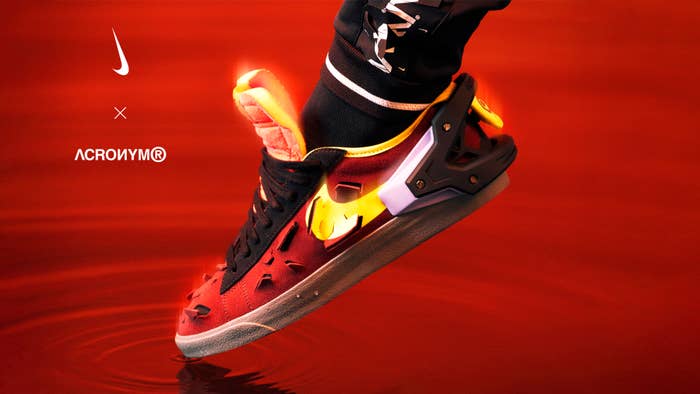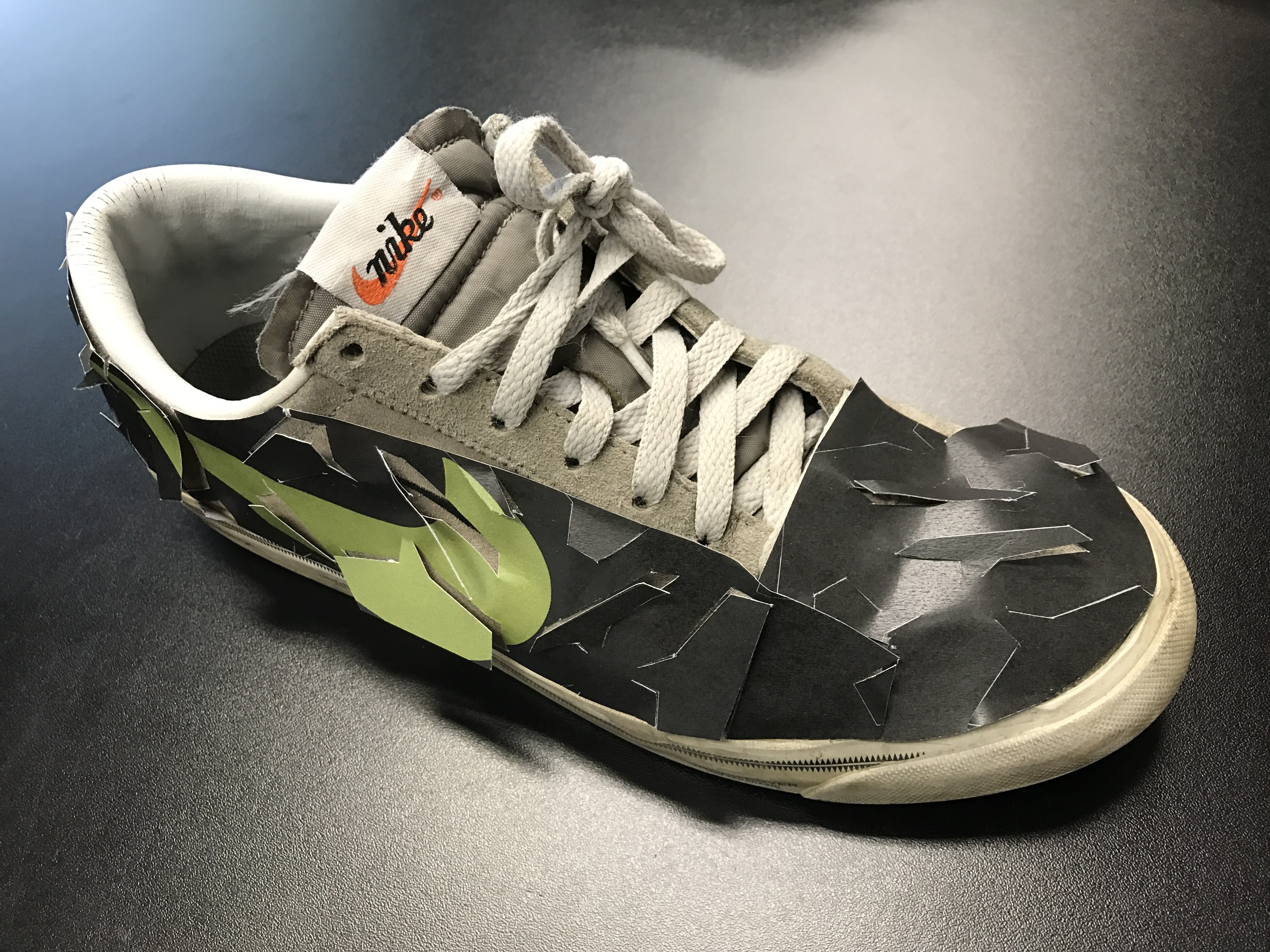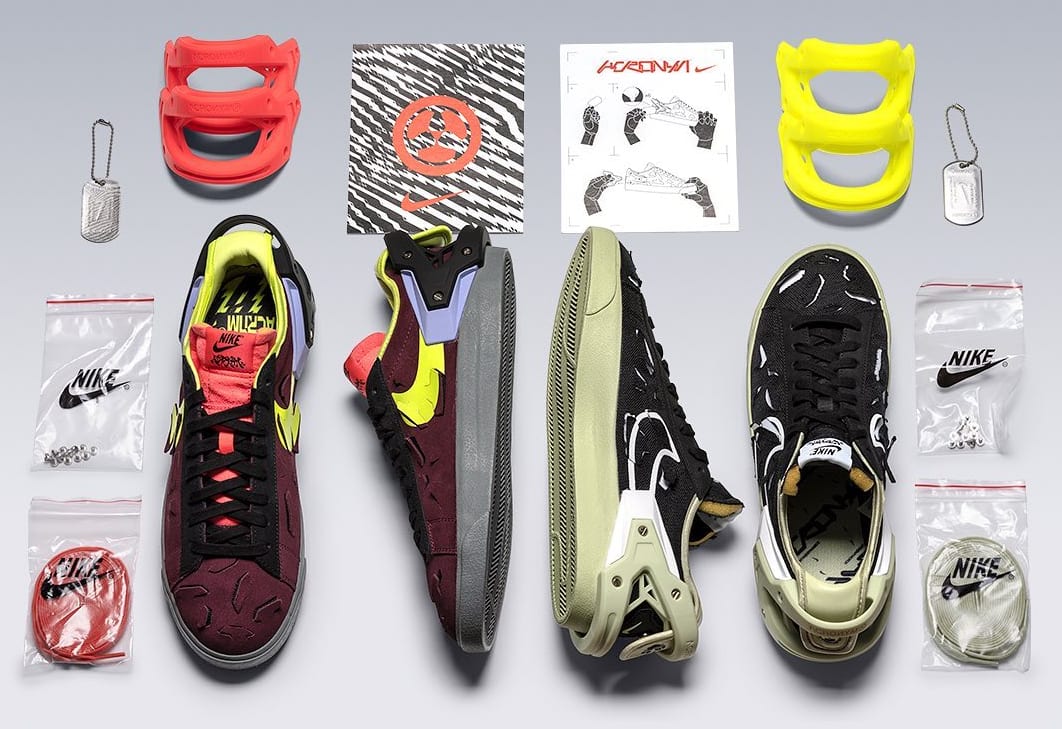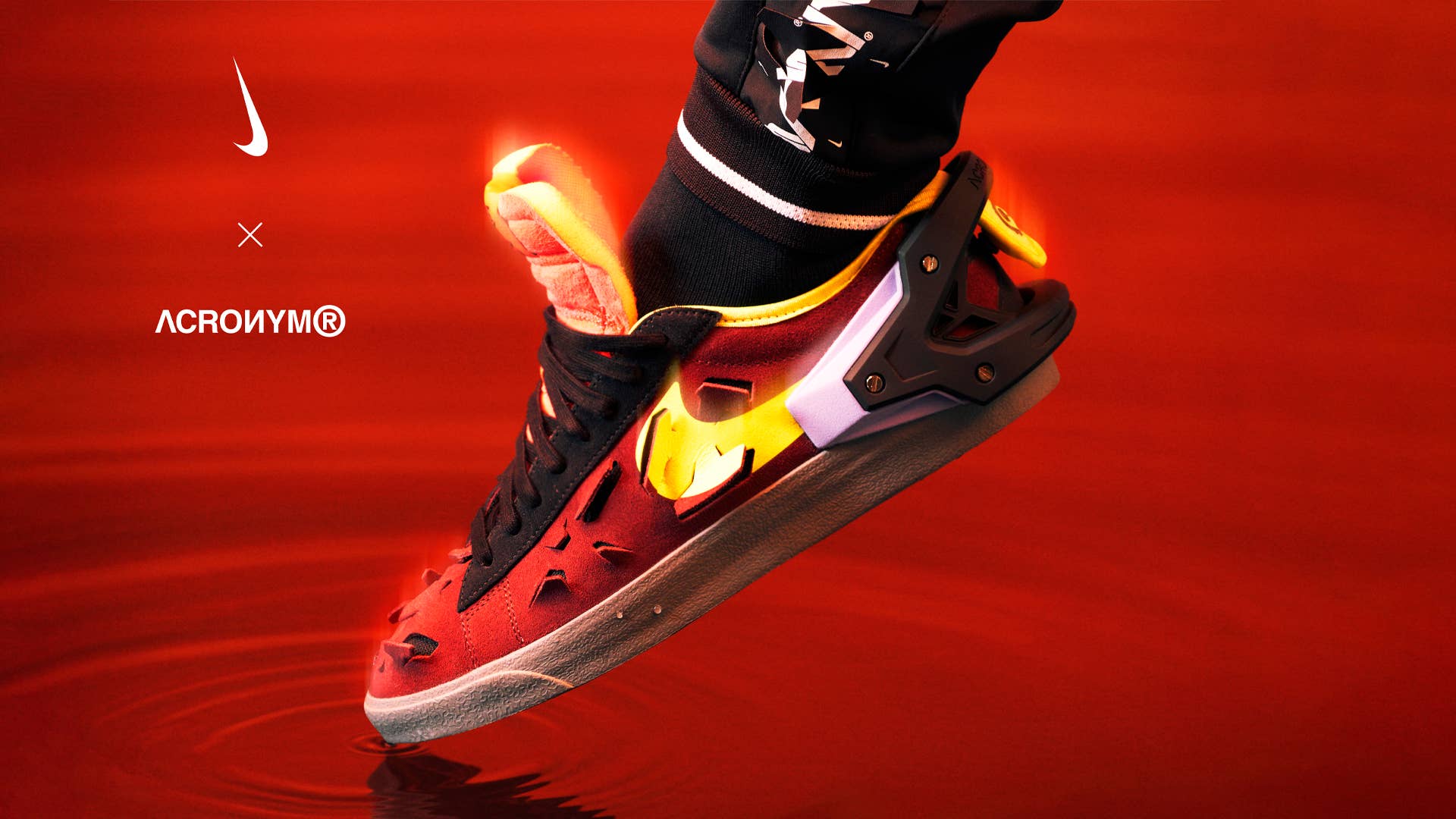
Acronym’s version of the Nike Blazer Low, a sneaker frilled on its upper with angular incisions and augmented at the back with a screwed-on heel counter, took a protracted, twisting path toward its commercial launch.
“The shoe itself had a really long journey for a couple of reasons,” said Errolson Hugh, the designer and co-founder of technical apparel brand Acronym, tracing the story of his Blazers during a launch event at German sneaker boutique Solebox last weekend.
It began in May 2017 as a prototype made by gluing a paper shroud with X-Acto cuts onto an existing base sneaker, the Fragment x Undercover x Nike Match Classic. At one point, Acronym’s Blazer collaboration was meant to take shape on the Nike Killshot, but then that model rotated out of Nike’s calendar. For a time the samples wore a draw-cord system, an innovation borrowed from Jordan Brand, but it wasn’t performing as intended. Then a global pandemic interrupted the Blazers’ development. A colorway got canceled along the way.
The Blazers are a product of Hugh navigating through Nike to push its limitations and maneuvering past the obstacles of working alongside such a mammoth company.
“You have to be ready for that,” he tells Complex, “and it’s your ability to handle those types of setbacks that will determine the outcome of a project, possibly even more than the design itself.”
A backstory so intricate is appropriate for a sneaker from Acronym, a brand built on details. Its jackets read like an Escher layout of zippers and pockets, seam lines bouncing off each other to set up some impossible structure. Its sneakers with Nike have reflected this, pushing archival models in new directions.

The closest relative of the Acronym x Nike Blazer Low though is not the brand’s past Nike collaborations—its Lunar Force 1s or its patterned VaporMaxes—but the Undercover adaptation of the Nike Daybreak from 2019. At Solebox, Hugh described how that shoe inspired his latest.
That Daybreaks, like the reimagined Blazers after them, has a chunky piece of plastic jutting off its rear. Hugh said that Nike’s designers worked on the part for two years, originally creating a collapsible heel frame that allowed the wearer to step down and take the shoe on or off without having to use laces. But it was not sufficiently novel.
“Just before they were about to go to market,” Hugh explained, “legal was like, ‘Hey, there’s a patent violation, so we can’t actually release this shoe.’”
Nike’s designers fortified the heel piece with a plastic shank to keep it from collapsing, avoiding potential litigation and neutering its purpose. (Months after the shoes’ release, hands-free sneaker brand Kizik announced an investment from Nike that came with an intellectual property license.) Hugh, who’s lived in the shoes since their release, discovered in the Undercover x Nike Daybreak some vestigial functionality.
“With the particular way that the upper’s formed,” he said, “and with that shank inside there giving it the stiffness, you can just set the laces once and put your foot in there and step down and the part that prevents the tailgate from collapsing actually works almost like a shoehorn.”
With that, his Blazer Lows found their muse. Acronym’s take on the retro basketball shoe has ghillie-patterned cuts on its upper, a shoehorn-like lip at the collar, and clips on the heel that act as stand-ins for the Daybreak’s tailgate. Short of a proper FlyEase system, they enable a quick-on, quick-off entry.
The final result of a half-decade of design input and development will arrive this week. The Acronym x Nike Blazer Low releases will comprise two colorways of the shoes, which will be available first on Acronym’s website on Wednesday, Feb. 9, and then via SNKRS and Nike retailers the following day. The shoes are priced at $140. Their rollout features commissioned graphics from Japanese graffiti writer NESM. The collection also uses work from typographer David Rudnick.

This Acronym project marks the first official apparel collaboration between the brand and Nike. Although its DNA has seeped into Nike clothing before: Hugh worked on apparel for the ACG line at the end of the 2010s, and there were promo T-shirts and hats created for the celebrated Acronym Presto series from 2016.
The commercial debut of the sneakers this week does not quite mean that their journey is done. In that vein, the Acronym x Nike Blazer Lows join recent projects like the Off-White x Air Jordan 5 and the Union x Air Jordan 4 that give the wearer some agency in what their shoes will look like. The heel clips on Acronym’s Blazers are interchangeable, allowing for a level of modularity.
Before the sneakers were finalized, a member of Nike’s design team suggested the idea of making the clips removable. Beyond that, Acronym is making available source files that will allow anyone with access to a 3D printer to make their own exoskeletal appendages for the sneakers. At the Solebox event, examples included a set of shark teeth and a bosozoku splitter stretching out from the Blazer’s back end.

“That type of design—hacking into something existing and changing it yourself—really actually reflects the process and the methodology we have at our studio in general,” said Hugh.
In addition to gathering notes on the sneaker’s development from its introduction at the Solebox, Complex connected with Hugh over email to discuss his ongoing work with Nike.
His correspondence allows for more levity than his brand does—while Acronym garments and their descriptions can feel serious to the point of intimidation, the man behind them does not. Hugh’s messages are punctuated by more textual laughter and chirpy exclamation marks than one expects from a man making blacked-out gear at the bleeding edge of jacket technology. In the interview, he reflects on his sneaker output and some of his more high-profile supporters. The conversation has been edited, just barely, for clarity.
Your collaborations with Nike are unique in that they are always more than just a new colorway on an existing model—you actually get to change the silhouettes. How hard is it to make that happen on a sneaker like the Air Force 1 or the Blazer?
It’s not hard conceptually, and Nike pretty much reached out to us because that’s what they were hoping to get from us. On a practical level, though, it takes a lot more time and effort. As in, you have to test it and make sure it works physically, especially if it’s a functional element. Whereas with color alone there’s obviously less of that aspect. I can’t blame the footwear development teams for being equal parts thrilled and terrified whenever they hear we’re doing another shoe. [Laughs.] Shoutout to Gerald [Sullivan] and Nate [Jobe] and the rest of the squad!

The exception to that is the Acronym x Nike Dunk High from 2009, which was the first Nike project you ever did and is more conservative in contrast to your later work with the brand. I know Jesse Leyva was involved, but what do you remember about doing that first shoe?
Actually I didn’t do anything except open the box, and write Jesse a thank you message! Jesse had made those as a surprise, and kind of as an intro to the idea of doing something with Nike. I believe this would have been SB at the time. [Editor’s note: The Dunk in question was not an SB Dunk.] Took a while longer to come together, but yeah those were super cool one-offs to get, obviously.
Is there a limit to how far you can push a sneaker collaboration? Are there things you’ve tried to do to certain shoes where Nike basically says you can’t take it quite that far?
With a company like Nike, or any larger organization, there’s going to be inherent limitations. Nike is a massive enterprise. The limitations of the logistics of doing anything are part of the process. You have to be ready for that, and it’s your ability to handle those types of setbacks that will determine the outcome of a project, possibly even more than the design itself.
The whole thing is people, really. If you don’t have people onboard, nothing is going to happen, no matter how good your idea seems.

The Acronym Blazer has this piece around the collar that looks like a built-in shoehorn. You replied to one person on Twitter explaining the purpose of the clip on the heel as a stabilizer. Is it important to you that people understand the work and what it’s meant to do?
We actually enjoy giving people things to discover. Or even just to make them curious. So yeah, I guess it’s not important that they understand the work! [Laughs.] That being said, it is important that there is a payoff when they do engage with it. Nothing is worse than a design that doesn’t deliver on its apparent promise. When you’re trying to do something new, you can’t expect people to understand it at first, but if they don’t understand it after investing into it, then you’ve lost them forever.
It feels like the context of the people who have the sneakers early—in this case Hideo Kojima and William Gibson—helps explain the world that they’re a part of. Did you get any feedback from those guys and do you get a sense of how into sneakers they are?
Yeah, there’s usually immediate feedback, especially with guys like those two, who are just fully aware and engaged with the world on many levels. You’d have to ask them, but I think they can sense that we approach this kind of thing from a different or unexpected angle and they appreciate that. Iconoclasts will recognize each other I believe.
Gibson called it dystopian sneaker design. Is that where your mind was at with this project?
Actually, no. We’re more into the idea of “protopia” right now, as in, incremental improvements to the world and its systems, rather than the “what could possibly go wrong” grand schemes of utopia, or the nihilism of dystopia. Coming from William Gibson though, I think dystopia might imply something else. We DM about the state of the world once in a while and I think dystopia presently could also mean “contemporary.” As in, this is a very current take on things. I could be wrong though! Maybe he just sees the end of it all when he looks down at his feet! [Laughs.]

